![]()
When it comes to root cellars, whether you’re a seasoned pro or a newbie, there could be some root cellar secrets that you don’t know.
Learn all about common root cellar mistakes, ingenious hacks, and what you can and can’t stockpile there.
Benefits of a Root Cellar
Of all the different homestead structures to include on your property, a root cellar is one that will make your home more resilient.
In a SHTF event, having a well-stocked root cellar ensures you can sustain your family for months.
Best of all, since it doesn’t require electricity, you’ll never have to worry about how to power it.
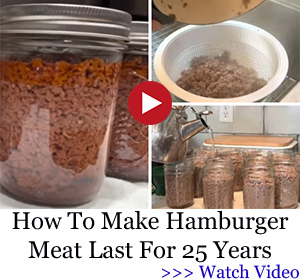 There are many other benefits of root cellars, but here are some of the most important ones:
There are many other benefits of root cellars, but here are some of the most important ones:
- Long-term food preservation
- Energy savings
- Back-up food supply for emergencies
- Decreased dependence on the globalized food industry
What Can Be Stored in a Root Cellar?
There are many ways to preserve food, but some are best kept in a root cellar to maintain better nutritive value and appeal.
Cellars are well-known for storing root vegetables like potatoes and carrots and fruits like apples and pears, but what else can you store in your root cellar?
Food to Store in Your Root Cellar
First, let’s cover the most common types of food that you can store in a root cellar.
- Root vegetables, including potatoes, carrots, parsnips, turnips, beets, onions, and garlic
- Fruits, including apples and pears.
- Other vegetables, including cabbage and pumpkins.
- Smoked foods, including salt pork, smoked fish, and jerky.
- Dairy products, including butter, cheese, milk, and cream.
- Miscellaneous products, including water, tortillas, and bread.
Obviously, all of these foods have different storage requirements and some last considerably longer than others. However, your root cellar can store a lot more than you think.
Homemade Wine, Beer, and Sodas
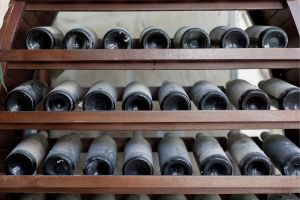 Root cellars are a great place to store homemade wine, beer, and sodas because they have very similar conditions to those needed for proper storage and aging of wine, just like wine cellars. Beer, wine, and sodas can all benefit from the cool, even temperatures that prevent spoilage, allowing flavors to develop nicely over time.
Root cellars are a great place to store homemade wine, beer, and sodas because they have very similar conditions to those needed for proper storage and aging of wine, just like wine cellars. Beer, wine, and sodas can all benefit from the cool, even temperatures that prevent spoilage, allowing flavors to develop nicely over time.
Perennial Bulbs and Flowers
While perennial bulbs and flowers aren’t edible, they need to be stored in a similar manner as the roots and tubers that we eat. Your prized dahlias can be safely kept in your root cellar, as can gladioli bulbs, begonias, and other flower bulbs and tubers.
What Can’t Be Stored in a Root Cellar?
What you can store in your root cellar depends on the climate you live in, how insulated your root cellar is, and how deep it is in the ground.
In general, keeping citrus or tropical fruits like bananas and oranges in a root cellar is not recommended. They emit too much ethylene gas and need warmer temperatures to ripen fully. You also can’t store grains in the root cellar because there is too much humidity, and they are likely to develop mold and mildew.
Related: Looming Grain Shortage. Do This Before It’s Too Late
While hard cheese is okay for long-term storage in a root cellar, soft cheeses and other dairy products won’t last long.
Ideally, your root cellar should be cool year round, maintaining a temperature between 32° and 40° F (0° and 4° C). At these temperatures, you can keep perishable foods such as milk, cream, and salad greens. However, many root cellars aren’t insulated well enough or are ventilated during the hottest parts of the day, which causes temperature fluctuations that lead to food spoilage.
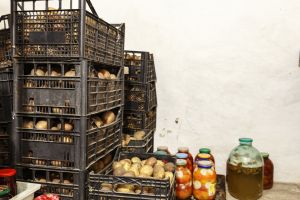 If you live in an area with a high water table, your root cellar could be too humid to store canning jars.
If you live in an area with a high water table, your root cellar could be too humid to store canning jars.
The high humidity can cause the metal to rust, ruining the seals and spoiling your food.
Knowing what to store in your root cellar may come down to experimentation.
What works in your root cellar may not work in your neighbor’s root cellar, and vice versa.
Top 8 Root Cellar Mistakes to Avoid
The best root cellar naturally takes care of many of the enemies of food storage: light, moisture, temperature, oxygen, time, and pests. However, even the best root cellars aren’t without problems. Here are some of the most common root cellar mistakes people make to lose the battle against food’s worst enemies.
Mistake #1: Not Curing Produce Before Storing It
Some vegetables need to be “cured” before going into the root cellar. For example, pumpkins will develop a hard shell if they’re allowed to sit in the sun for about two weeks. Onions and garlic are other items that need to be cured.
Mistake #2: Poor Ventilation
Your root cellar should be properly vented to eliminate stagnant air, which can lead to mold and mildew growth. Install vent pipes to exchange the stale air in your root cellar with fresh air from outside.
If possible, use a timer or thermostat switch to ensure that your root cellar is only ventilated during the coolest parts of the day.
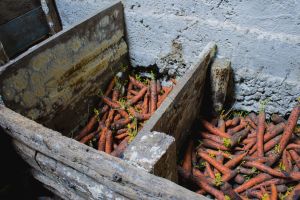
Ensuring proper ventilation is just one of many steps in creating an efficient root cellar. If you’re looking to build a cheap and effective root cellar in your backyard or want to correct mistakes in your existing one, this guide is invaluable. It provides practical tips and step-by-step instructions to help you get the most out of your root cellar.
Mistake #3: Incorrect Humidity Levels
Different types of foods require various humidity levels for proper storage. Many people accomplish this simply by putting food that needs to be drier, such as potatoes, higher up off the ground.
Food that needs more moisture, like carrots and parsnips, can be placed lower to the ground. A more scientific approach is to use hygrometers at various heights and different spots in your root cellar.
Mistake #4: Fluctuating Temperatures
If you were ever yelled at as a kid to close the refrigerator door to keep the cool air from escaping, then you understand what happens every time you open the door to your root cellar. Try to avoid opening your cellar during the hot parts of the day and seal up any cracks, especially around the door. And insulate everything–even your ventilation pipes.
In northern regions during the winter, you may face a different problem: freezing. If the temperature in your root cellar drops below 32°F (0°C), then your food will spoil.
Mistake #5: Not Keeping Certain Foods Separate
Fruits like apples give off ethylene gas as they ripen, which can make the produce around them go bad faster.
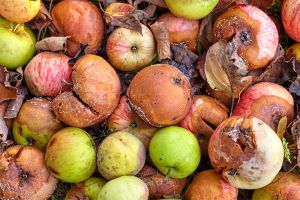
Keep apples and pears in a separate room or vent them separately if possible. You can wrap them in newspaper or keep them in a cardboard box to limit the amount of air circulation. If you make shallow wooden boxes so you can place your apples in a single layer, it’s much easier to keep an eye on them so they last longer.
Mistake #6: Keeping Onions and Garlic Low to the Ground
Onions and garlic will keep well in a root cellar as long as they maintain the right humidity. However, they do best when stored high up off the ground on a vegetable rack or in a hanging basket.
Some people hang them from the root cellar rafters in old pantyhose, which allows them to breathe but keeps them off the floor. They also do better when they are cured before storing so the dry, outer skin develops.
Mistake #7: Ignoring Regular Inspections
Regular inspections will ensure that you can maintain proper temperature and humidity. During inspections, you can also rotate stock and get rid of produce that has started to go bad. But one of the most important reasons to conduct regular inspections is to prevent pest damage to your food supply.
Rats and mice have naturally evolved to live near and around humans, and they consider our food supplies to be their own. Unless you take appropriate measures, they can destroy your hard work by taking nibbles or leaving urine and feces all over the place. Prevention can include traps, essential oil sprays, and homemade remedies like neem oil and vinegar sprays.
Mistake #8: Skipping Seasonal Cleanings
Late spring is a great time to clean your root cellar, so adding it to your spring checklist is a good idea. Most of the food that you store over the winter won’t be usable after the end of spring, so you can clear out anything that remains and feed it to your chickens or weaner pigs.
Spray out your root cellar with a 10% bleach solution, which will help remediate any mold and mildew that can cause food spoilage problems.
Unlock the Full Potential of Your Root Cellar
Root cellars are invaluable, especially if you’re a gardener and you want to put up a lot of food to feed your family and prepare for emergencies.



